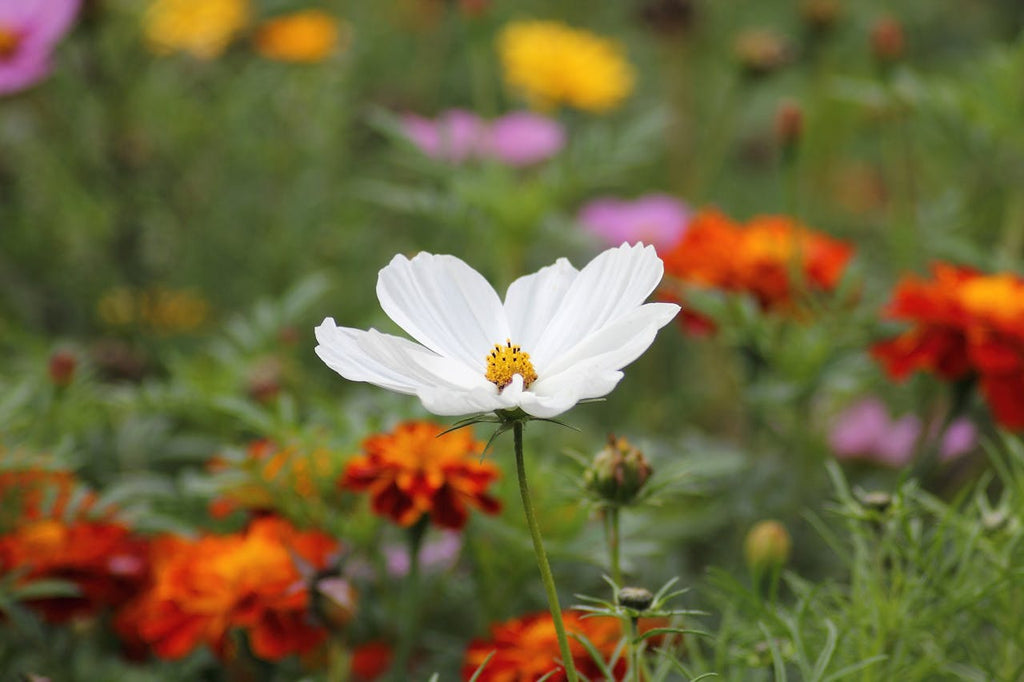Bees are crucial for pollination, and planting bee-friendly flowers not only helps support local ecosystems but also encourages vibrant, healthy gardens. Here's a florist guide to some of the best flowers that attract bees, categorized by type and blooming season:
1. Sunflowers (Helianthus spp.)
-
Bloom Time: Late Summer to Fall
-
Bee Appeal: Sunflowers are a favorite of many bee species, including honeybees. Their large, vibrant flowers provide plenty of pollen and nectar.
-
Tip: Plant sunflowers in full sun to encourage bee activity. They thrive in well-drained soil.
2. Lavender (Lavandula spp.)
-
Bloom Time: Summer
-
Bee Appeal: Lavender is highly attractive to bees, especially honeybees and bumblebees. The long, spiky flower heads are full of nectar.
-
Tip: Grow lavender in well-drained soil with plenty of sunlight. It's drought-tolerant once established.
3. Borage (Borago officinalis)
-
Bloom Time: Spring to Summer
-
Bee Appeal: Borage has star-shaped blue flowers that bees adore. It’s an excellent nectar source, especially for honeybees.
-
Tip: Borage can grow in most soils, but it prefers full sun. It also self-seeds, so it may return year after year.
4. Coneflower (Echinacea spp.)
-
Bloom Time: Mid-Summer to Fall
-
Bee Appeal: Coneflowers, with their distinctive daisy-like shape, are popular with bees, particularly bumblebees. The broad petals provide easy access to nectar.
-
Tip: Plant in full sun and well-drained soil. Coneflowers are drought-tolerant once established.
5. Bee Balm (Monarda spp.)
-
Bloom Time: Summer to Early Fall
-
Bee Appeal: Bee balm has fragrant, tubular flowers that attract bees and other pollinators like hummingbirds. It’s known for its vibrant colors such as pink, red, and purple.
-
Tip: Prefers moist, well-drained soil and partial to full sun.
6. Clover (Trifolium spp.)
-
Bloom Time: Spring to Fall
-
Bee Appeal: Clover is a natural favorite for bees. Its small, dense flowers provide ample nectar and pollen. It's also easy to grow in lawns.
-
Tip: It thrives in well-drained, slightly acidic soil and prefers partial sun to full sun.
7. Thyme (Thymus vulgaris)
-
Bloom Time: Spring to Summer
-
Bee Appeal: Thyme is a great herb that attracts bees, especially when it flowers. The tiny blossoms are rich in nectar, making them irresistible to pollinators.
-
Tip: Plant thyme in a sunny, well-drained area. It's also a great culinary herb to have in your garden.
8. Wildflowers (Mixed)
-
Bloom Time: Varies (Typically Spring to Fall)
-
Bee Appeal: Wildflowers, including species like poppies, daisies, and clovers, are wonderful for attracting a variety of bees. They offer a buffet of different nectar sources.
-
Tip: Plant a wildflower meadow for a variety of blooms throughout the season. Wildflowers are often low-maintenance and support pollinators all year long.
9. California Poppy (Eschscholzia californica)
-
Bloom Time: Spring to Summer
-
Bee Appeal: The vibrant orange flowers of the California poppy are a magnet for bees, particularly in warmer regions. Its nectar is particularly attractive to honeybees.
-
Tip: Prefers dry, well-drained soil and full sun.
10. Zinnias (Zinnia spp.)
-
Bloom Time: Summer to Fall
-
Bee Appeal: Zinnias are very attractive to bees, particularly their vibrant, single-petaled varieties. They are rich in nectar, making them a perfect choice for pollinators.
-
Tip: Zinnias prefer full sun and well-drained soil. They're also heat-tolerant and resistant to disease.
11. Salvia (Salvia spp.)
-
Bloom Time: Late Spring to Fall
-
Bee Appeal: Salvia’s tubular flowers in shades of purple, red, and blue attract bees and butterflies. Bees love the nectar-filled blooms, especially bumblebees.
-
Tip: Grow in well-drained soil in a sunny location. Salvia is drought-tolerant once established.
12. Hyssop (Hyssopus officinalis)
-
Bloom Time: Summer
-
Bee Appeal: Hyssop produces spikes of small, tubular flowers that bees find irresistible. The plant is aromatic and rich in nectar.
-
Tip: Plant in full sun with well-drained soil. It can tolerate dry conditions once established.
13. Goldenrod (Solidago spp.)
-
Bloom Time: Late Summer to Fall
-
Bee Appeal: Goldenrod is a late-season favorite for bees. Its clusters of yellow flowers provide a final nectar boost before winter.
-
Tip: Goldenrod thrives in full sun and well-drained soil. It’s also great for adding autumn color to your garden.
14. Aster (Aster spp.)
-
Bloom Time: Late Summer to Fall
-
Bee Appeal: Asters are perfect for attracting bees in the fall, when many other plants are winding down. The daisy-like flowers offer rich nectar.
-
Tip: Plant in full sun with well-drained soil. Asters can tolerate cooler temperatures, making them ideal for fall blooms.
15. Red Clover (Trifolium pratense)
-
Bloom Time: Late Spring to Early Summer
-
Bee Appeal: Red clover attracts a variety of bee species with its dense, globular flower heads. It’s an important food source for bees.
-
Tip: Red clover grows best in slightly acidic, well-drained soil and full sun.
Additional Tips for Attracting Bees:
-
Choose Native Plants: Native flowers are adapted to your region and often provide the best food sources for local bee populations.
-
Avoid Pesticides: Pesticides can harm bees. Opt for organic or natural pest control methods.
-
Provide Water: Bees need water, so having a shallow dish of water with rocks or sticks for them to land on can be helpful.
-
Plant in Clusters: Bees are more likely to visit flowers that are grouped together. Cluster flowers by color or type to create more impactful bee-friendly areas.
By planting these bee-friendly flowers and following these tips, you can create a vibrant, pollinator-friendly garden that supports the health of local bee populations.



